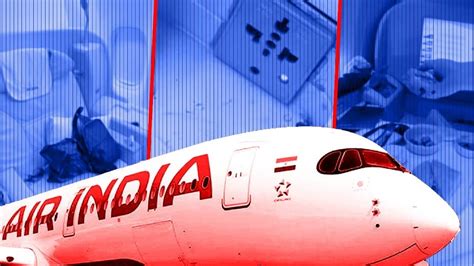
A viral video has surfaced depicting widespread malfunctions aboard an Air India flight, exposing non-operational screens, faulty lighting, and broken seats, sparking passenger outrage and raising serious concerns about the airline’s maintenance standards and passenger safety.
Passengers aboard an Air India flight recently endured a harrowing experience after a video emerged showcasing a plethora of malfunctioning systems, turning what should have been a routine journey into a nightmare of discomfort and frustration. The footage, widely circulated on social media, paints a grim picture of the airline’s maintenance standards, revealing broken entertainment screens, inoperable reading lights, damaged seats, and other significant issues that plagued the flight. This incident has triggered widespread criticism of Air India and raised serious concerns about passenger safety and comfort.
The video, which quickly went viral, shows a passenger documenting the various malfunctions within the cabin. One clip displays a non-functional entertainment screen, rendering inflight entertainment unavailable for that passenger. Another section of the video highlights a broken reading light, leaving passengers in the dark and unable to read or work comfortably. Perhaps most alarming, several seats are shown to be damaged or broken, potentially posing a safety risk and causing considerable discomfort during the flight.
“Nothing is working,” the passenger recording the video can be heard saying, underscoring the pervasive nature of the problems. The person added in a caption, “What is happening @airindia? This is not the standard we expect!”
The incident has ignited a firestorm of criticism directed at Air India, with many questioning the airline’s commitment to maintaining its fleet and ensuring passenger safety. Social media platforms have been flooded with comments expressing outrage and disappointment, with many users sharing their own negative experiences with the airline.
“This is unacceptable,” wrote one Twitter user. “Air India needs to take immediate action to address these issues and ensure the safety and comfort of their passengers.”
Another user commented, “I’ve had similar experiences with Air India in the past. Their maintenance standards are clearly lacking.”
The incident comes at a particularly sensitive time for Air India, which is currently undergoing a major transformation under the ownership of the Tata Group, which reacquired the airline in January 2022 after decades of state control. The Tata Group has pledged to invest heavily in modernizing the airline’s fleet, improving its service standards, and restoring its reputation as a world-class carrier. However, this incident highlights the significant challenges that the airline faces in its efforts to turn around its operations and regain the trust of its customers.
Air India has yet to issue an official statement regarding the video and the reported malfunctions. However, industry experts say the airline will likely face intense scrutiny from regulators and the public.
“This video is a major embarrassment for Air India,” said aviation analyst Sameer Verma. “It raises serious questions about the airline’s maintenance procedures and its commitment to passenger safety. Air India needs to take swift and decisive action to address these issues and restore public confidence.”
The incident underscores the importance of regular maintenance checks and rigorous safety inspections for airlines. Airlines have a responsibility to ensure that their aircraft are in proper working order and that all systems are functioning correctly before each flight. Failure to do so can not only lead to passenger discomfort but also potentially compromise safety.
The Air India flight fiasco serves as a stark reminder of the challenges that airlines face in maintaining their fleets and providing a safe and comfortable travel experience for their passengers. It also highlights the power of social media in holding airlines accountable and demanding higher standards of service. As Air India embarks on its transformation journey, it will need to address these issues head-on and demonstrate a clear commitment to improving its maintenance standards and enhancing the overall passenger experience. The incident serves as a critical test of the Tata Group’s ability to turn around the airline and restore its reputation as a reliable and world-class carrier. The world is watching, and Air India’s response will be crucial in determining its future success.
In-Depth Analysis and Background Information
The Air India incident reflects broader systemic issues within the aviation industry related to maintenance, aging fleets, and the balance between cost-cutting measures and passenger safety. For decades, Air India struggled under government ownership, burdened by bureaucratic inefficiencies, financial constraints, and a lack of investment in infrastructure and maintenance. This resulted in an aging fleet, deferred maintenance schedules, and a decline in service standards. The Tata Group’s acquisition of Air India was hailed as a turning point, offering the promise of much-needed investment, modernization, and a renewed focus on customer satisfaction. However, the recent incident underscores the magnitude of the challenges that the new management team faces in transforming the airline.
Maintenance Deficiencies: A Root Cause Analysis
The video evidence of widespread malfunctions suggests significant deficiencies in Air India’s maintenance practices. This could stem from several factors, including:
-
Inadequate Maintenance Budgets: Years of financial constraints under government ownership may have led to underfunding of maintenance programs, resulting in deferred repairs and a backlog of maintenance tasks.
-
Insufficient Staffing: A shortage of qualified maintenance personnel could also contribute to the problem. Properly trained and experienced technicians are essential for conducting thorough inspections, identifying potential problems, and performing necessary repairs.
-
Poor Quality Control: Lax quality control procedures could allow substandard repairs or incomplete maintenance tasks to go unnoticed, leading to recurring problems and potential safety hazards.
-
Aging Fleet: Operating an aging fleet of aircraft can also increase the likelihood of malfunctions. Older aircraft require more frequent maintenance and are more prone to mechanical failures due to wear and tear.
-
Supply Chain Issues: Delays in obtaining spare parts or components can also disrupt maintenance schedules and lead to temporary fixes that may not be as reliable as permanent repairs.
Impact on Passenger Safety and Comfort
The malfunctions documented in the video not only caused discomfort and inconvenience for passengers but also raised potential safety concerns. Broken seats, for example, could pose a risk of injury during turbulence or emergency landings. Non-functional lighting could hinder evacuation procedures in the event of an emergency. Moreover, the overall state of disrepair can create a sense of unease and distrust among passengers, undermining their confidence in the airline’s commitment to safety.
Regulatory Scrutiny and Compliance
Airlines are subject to strict regulations and oversight by aviation authorities, such as the Directorate General of Civil Aviation (DGCA) in India and the Federal Aviation Administration (FAA) in the United States. These agencies conduct regular inspections to ensure that airlines comply with safety standards and maintenance requirements. The Air India incident is likely to trigger a thorough investigation by the DGCA to determine whether the airline has violated any regulations and to identify the root causes of the maintenance deficiencies. If violations are found, the DGCA could impose penalties, such as fines, grounding of aircraft, or even revocation of the airline’s operating license.
The Tata Group’s Transformation Plan
The Tata Group has unveiled an ambitious plan to transform Air India into a world-class airline. This plan includes:
-
Fleet Modernization: Investing in new, fuel-efficient aircraft to replace aging planes and reduce operating costs.
-
Service Enhancement: Improving passenger experience through better catering, in-flight entertainment, and customer service.
-
Operational Efficiency: Streamlining operations, reducing costs, and improving on-time performance.
-
Infrastructure Development: Upgrading airport facilities and investing in new technologies to enhance operational efficiency.
-
Employee Training: Providing comprehensive training to employees to improve their skills and knowledge.
The Air India incident highlights the urgent need for the Tata Group to address the airline’s maintenance deficiencies and to accelerate its transformation plan. The airline must prioritize safety, invest in maintenance, and ensure that its aircraft are in proper working order. It must also improve its customer service and restore passenger confidence in the airline’s ability to provide a safe and comfortable travel experience.
The Role of Social Media in Holding Airlines Accountable
The Air India incident underscores the growing power of social media in holding airlines accountable for their actions. Passengers are increasingly using social media platforms to share their experiences, voice their complaints, and demand better service. Viral videos and online campaigns can quickly amplify these concerns and put pressure on airlines to address the issues. Airlines that fail to respond to these concerns risk damaging their reputations and losing customers.
Comparative Analysis: Other Airline Maintenance Incidents
The Air India incident is not an isolated case. Over the years, there have been numerous incidents involving other airlines that have highlighted maintenance deficiencies and their impact on passenger safety. Some notable examples include:
-
Alaska Airlines Flight 261 (2000): A fatal crash caused by inadequate maintenance of the aircraft’s horizontal stabilizer.
-
ValuJet Flight 592 (1996): A fatal crash caused by improperly stored oxygen generators.
-
Qantas Flight 32 (2010): An engine failure caused by a manufacturing defect and inadequate maintenance procedures.
These incidents underscore the importance of rigorous maintenance standards and strict regulatory oversight in the aviation industry. They also highlight the potential consequences of neglecting maintenance and prioritizing cost-cutting over safety.
The Future of Air India
The future of Air India depends on its ability to overcome its past challenges and to successfully implement its transformation plan. The airline must prioritize safety, invest in maintenance, improve customer service, and restore passenger confidence. The Tata Group has the resources and the expertise to turn Air India around, but it will require a sustained commitment to excellence and a willingness to address the airline’s systemic problems. The Air India incident serves as a wake-up call, reminding the airline that it must earn the trust of its passengers and demonstrate a clear commitment to safety and quality. The success of Air India’s transformation will not only benefit the airline but also contribute to the growth and development of the Indian aviation industry as a whole.
Expanded Context and Further Considerations
Beyond the immediate issues of malfunctioning entertainment systems and broken seats, the Air India incident touches upon broader issues related to airline operations, customer expectations, and the role of technology in shaping travel experiences.
The Evolving Expectations of Airline Passengers:
In an increasingly competitive market, airlines are constantly striving to differentiate themselves and attract customers. Passengers have become more discerning and demanding, expecting not only safe and reliable transportation but also a comfortable and enjoyable travel experience. This includes access to in-flight entertainment, comfortable seating, reliable Wi-Fi, and attentive customer service. When these expectations are not met, passengers are quick to voice their dissatisfaction, particularly through social media.
The Impact of Technology on Airline Operations and Passenger Experience:
Technology plays a crucial role in modern airline operations, from aircraft maintenance and flight scheduling to passenger booking and in-flight entertainment. Airlines are increasingly relying on data analytics and artificial intelligence to optimize their operations, improve efficiency, and enhance the passenger experience. For example, predictive maintenance technologies can help airlines identify potential maintenance issues before they lead to malfunctions, reducing downtime and improving safety. In-flight entertainment systems offer a wide range of movies, TV shows, music, and games, providing passengers with a personalized entertainment experience. Wi-Fi connectivity allows passengers to stay connected with work, family, and friends while in the air.
The Challenges of Maintaining an Aging Fleet in a Cost-Competitive Environment:
Many airlines, particularly those in developing countries, face the challenge of maintaining an aging fleet of aircraft in a cost-competitive environment. Replacing older aircraft with newer, more fuel-efficient models requires significant capital investment, which may not be feasible for all airlines. As a result, airlines often resort to extending the lifespan of their existing aircraft through extensive maintenance and refurbishment programs. However, this can be a costly and complex undertaking, requiring specialized expertise and access to spare parts. Airlines must carefully balance the costs of maintaining an aging fleet with the benefits of investing in new aircraft.
The Importance of Transparency and Communication in Crisis Management:
When incidents like the Air India flight fiasco occur, it is crucial for airlines to respond quickly and transparently. This includes acknowledging the problem, apologizing to affected passengers, providing clear and accurate information, and taking steps to address the underlying issues. Airlines that fail to communicate effectively risk further damaging their reputations and losing the trust of their customers. Social media can be a powerful tool for airlines to communicate with passengers and respond to their concerns in real-time.
The Broader Economic and Social Implications of Airline Performance:
The performance of airlines has significant economic and social implications. Airlines play a vital role in connecting people, facilitating trade, and promoting tourism. A well-functioning aviation industry can contribute to economic growth, create jobs, and improve the quality of life for people around the world. Conversely, airline failures and disruptions can have a negative impact on the economy, tourism, and international relations.
Lessons Learned from the Air India Incident:
The Air India incident provides several valuable lessons for airlines, regulators, and passengers alike:
- Safety must always be the top priority. Airlines must invest in maintenance, ensure that their aircraft are in proper working order, and comply with all safety regulations.
- Customer service is essential. Airlines must provide a comfortable and enjoyable travel experience for their passengers, including access to in-flight entertainment, comfortable seating, and reliable Wi-Fi.
- Transparency and communication are crucial in crisis management. Airlines must respond quickly and transparently to incidents, providing clear and accurate information to affected passengers.
- Social media can be a powerful tool for holding airlines accountable. Passengers should use social media to share their experiences, voice their complaints, and demand better service.
- Regulators must enforce safety standards and hold airlines accountable for violations. Aviation authorities must conduct regular inspections and take swift action against airlines that fail to comply with safety regulations.
By learning from the Air India incident, airlines can improve their operations, enhance the passenger experience, and ensure the safety and reliability of air travel.
The Role of Pilot Reporting and Crew Awareness
Another critical, often overlooked, aspect of airline safety and maintenance is the role of the flight crew. Pilots and cabin crew are the first line of defense in identifying and reporting potential issues with an aircraft. Their observations during pre-flight checks and in-flight operations are invaluable for ensuring that maintenance personnel are aware of any problems that need to be addressed. A robust reporting system, where crew members feel empowered to report even minor issues without fear of reprisal, is essential for maintaining a safe and reliable fleet. In the Air India case, it remains unclear whether the issues highlighted in the video were previously reported by crew members, or whether they were newly discovered by passengers during the flight. A thorough investigation should examine the crew’s awareness of these issues and whether the existing reporting mechanisms are functioning effectively.
The Importance of Cabin Condition Monitoring
While mechanical and technical aspects of aircraft maintenance often receive the most attention, maintaining the condition of the cabin interior is also crucial for passenger comfort, safety, and overall satisfaction. Broken seats, faulty lighting, and malfunctioning entertainment systems not only detract from the passenger experience but can also pose safety risks in certain situations. Airlines should implement a robust cabin condition monitoring program, which includes regular inspections, preventative maintenance, and timely repairs. This program should be integrated with the overall aircraft maintenance schedule to ensure that all aspects of the aircraft, both technical and cosmetic, are properly maintained.
The Impact of Labor Relations on Maintenance Quality
The relationship between airline management and maintenance personnel can also have a significant impact on the quality of maintenance. If maintenance workers are overworked, underpaid, or lack adequate training, it can lead to errors, shortcuts, and a decline in overall maintenance quality. Airlines should invest in their maintenance workforce, providing them with competitive wages, comprehensive training, and a supportive work environment. Strong labor relations, based on mutual respect and collaboration, are essential for ensuring that maintenance personnel are motivated and committed to providing the highest quality of service.
The Potential for Technological Solutions in Cabin Maintenance
Emerging technologies offer new possibilities for improving cabin maintenance and enhancing the passenger experience. For example, sensors can be used to monitor the condition of seats, lighting, and entertainment systems, providing real-time data to maintenance personnel. Augmented reality (AR) and virtual reality (VR) technologies can be used to train maintenance workers and assist them in performing complex repairs. Predictive analytics can be used to forecast potential cabin maintenance issues, allowing airlines to proactively address them before they lead to malfunctions.
FAQ
-
What specific issues were highlighted in the Air India flight video?
The video revealed a range of malfunctions, including non-operational entertainment screens, broken reading lights, and damaged or broken seats. The passenger recording the video stated that “nothing is working,” indicating a pervasive nature of the problems.
-
What has been the public’s reaction to the video?
The video has sparked widespread criticism of Air India, with many questioning the airline’s commitment to maintaining its fleet and ensuring passenger safety. Social media platforms have been flooded with comments expressing outrage and disappointment, with many users sharing their own negative experiences with the airline.
-
What is Air India’s response to the incident?
As of the information available, Air India has not yet issued an official statement regarding the video and the reported malfunctions.
-
How might this incident affect Air India’s transformation under the Tata Group?
The incident poses a significant challenge to Air India’s transformation efforts, highlighting the need for urgent improvements in maintenance standards and customer service. It tests the Tata Group’s ability to address systemic problems and restore public confidence in the airline.
-
What regulatory actions could Air India face as a result of this incident?
The incident is likely to trigger an investigation by aviation authorities, such as the DGCA, to determine whether Air India has violated any safety regulations. Penalties could include fines, grounding of aircraft, or even revocation of the airline’s operating license, depending on the findings of the investigation.









